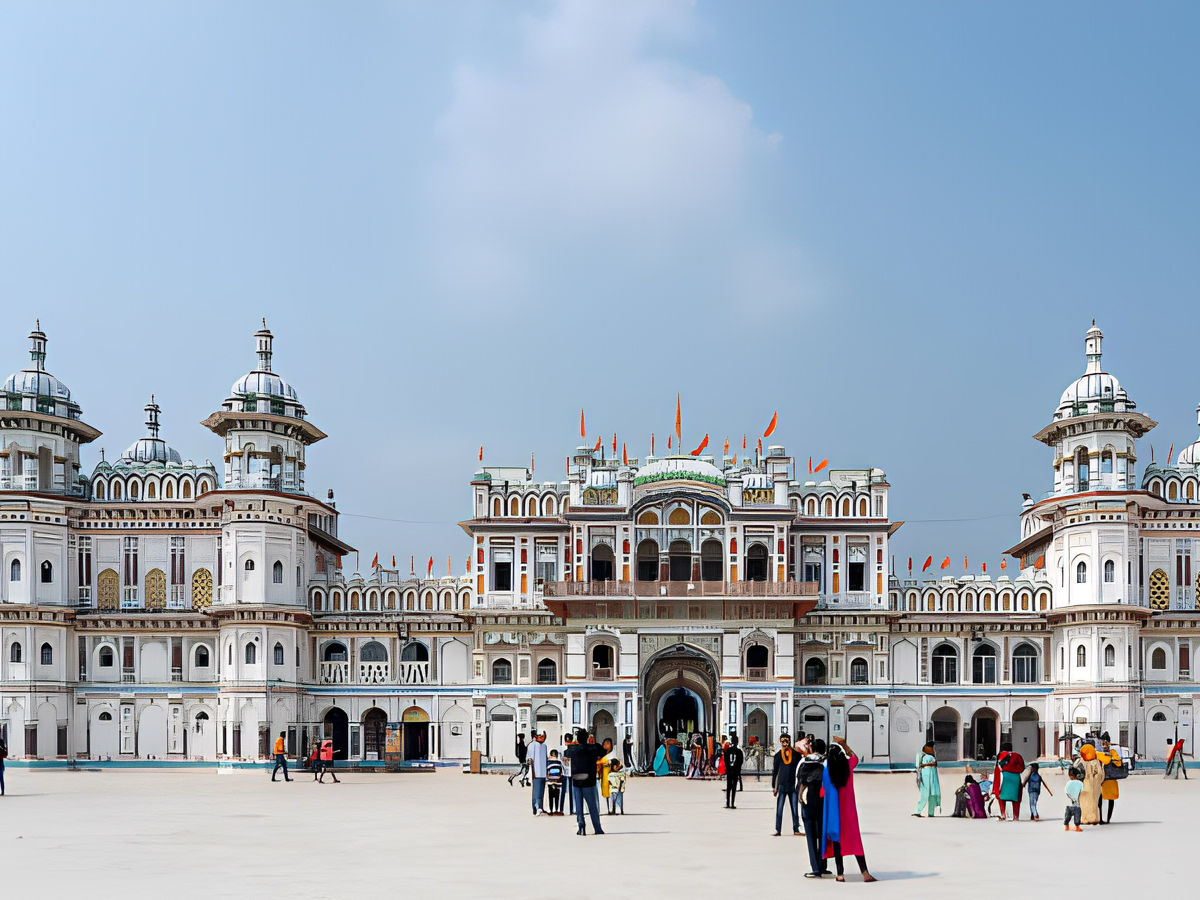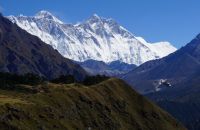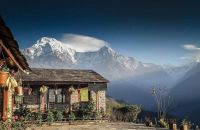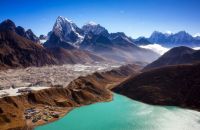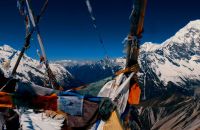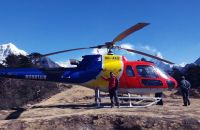Talk with our local travel specialist who can help organize your trip.
10 of the Most Beautiful Sacred Sites in Nepal
Table of Content
1. Pashupatinath - The most revered Hindu temple
You won't perhaps find any devout Hindu in Nepal who has not yet been to this sacred temple. Pashupatinath Temple sits on the banks of the holy Bagmati River in the Kathmandu Valley, is a sacred pilgrimage site revered by Hindus worldwide as it is dedicated to Lord Shiva. Its sanctity is rooted in the belief that Pashupatinath, the Lord of Animals, protects the entire universe.
Built in the fifth century and later renovated by various reining kings of Nepal, the temple's ancient pagoda-style architecture reflects the rich cultural and religious history. It is a UNESCO World Heritage site. The structure is built from intricate wood carvings of different gods and goddesses, has a famous golden roof, and a sacred Lingam, which symbolizes the divine energy from the formation of the universe.
While non-Hindu tourists cannot enter the main gates of the temple, they can observe its majestic figure from across the river. The vicinity of the temple is large and surrounded by forests. It is one of the most revered sites of Nepal, where national as well as international tourists seek spiritual healing.
2. Boudhanath Stupa
Nepal has a good blend of religion as a secular country, so you'll also find the most revered Buddhist temple here. Boudhanath Stupa is a spiritual magnificence and an iconic symbol of Tibetan Buddhism in Nepal. One of the largest stupas domes in the world, it is located on the eastern outskirts of Kathmandu. The Stupa was built in the 5th century by the ruling Licchavidynasty. It serves as a focal point for Tibetan Buddhist practices in the Kathmandu Valley and is also a UNESCO World Heritage Site.
The structure has a massive mandala decorated on the dome with the watchful eyes of Buddha, symbolizing wisdom and compassion. The Stupa is adorned with prayer flags fluttering in the wind and the prayer wheels surrounding it. As per legend, the Stupa enshrines the remains of Kassapa Buddha, linking it to ancient folklore and adding a mystical touch to its allure.
It is one of the most peaceful retreats where you'll find devotees circumambulating clockwise during the mornings and evenings with gentle sounds of hymns. The site's spiritual atmosphere and beauty pull many devotees, tourists, and photographers alike.
3. Lumbini - The Birthplace of Lord Buddha
Lumbini, synonymous with the birthplace of Lord Buddha, is a UNESCO World Heritage Site and a pilgrimage destination for Buddhists worldwide. It holds high significance for pilgrims visiting its hallowed grounds to pay homage to the enlightened. The mythical allure of the place has been added by the legends surrounding the miraculous events at the time of Buddha's birth.
Located in the southwestern plains in Nepal's Rupandehi District, the heritage site is believed to have been established in the 3rd century BCE. The site includes many unique temples and structures, the most popular among which is the Maya Devi temple, which enshrines the spot where Queen Mother Maya Devi gave birth to Prince Siddhartha (who later became Buddha) beneath a sacred sal tree. Due to the archaeological significance of this place, there are remnants of ancient monasteries and stupas. Another amazing infrastructure is the Ashoka Pillar was built by Emperor Ashoka in the 3rd century BCE, which serves as a testament to the spread of Buddhism across Asia.
The vast vicinity of Lumbini, with its tranquil gardens, surrounding temples, and ponds, creates a spiritual aura for visitors.
4. Swyambhunath Stupa - The Monkey Temple
Known affectionately as the Monkey Temple, the Swayambhunath Stupa is one of the most visited sacred sites by tourists. The Stupa, which perches atop a hill overlooking the Kathmandu Valley, embodies the eternal wisdom of the Buddha. It is a spiritual haven for both Buddhist and Hindu pilgrims.
While there isn't an accurate account, this UNESCO World Heritage site is known to have existed for over 2,500 years. There has been folklore surrounding how the Stupa emerged from the ground and thus earned the name "self-arisen." It represents the primordial Buddha and the voice of Buddhism.
The Stupa's infrastructure includes the whitewashed dome decorated with the 'eyes of Buddha", prayer flags, prayer wheels, and the presence of playful monkeys in the background. The distinct charm of the temple is also reflected by the amazing views of the Kathmandu valley from the hilltop. Tourists and pilgrims visit the spot to seek spirituality and peace.
5. Muktinath Temple
Another famous shrine for the Hindus and Buddhists is the Muktinath temple, best known for being one of the highest-located temples. Nestled in the western region of Nepal in Mustang at an altitude of 3,710 meters, it is dedicated to Lord Vishnu. The meaning of Muktinath is the"Lord of Liberation," making it a significant pilgrimage site for those seeking spiritual freedom.
Muktinath is known to be constructed in the 19th century and boasts a distinctive pagoda-style architecture. Another important feature of the temple is its 108 water spouts shaped like bull's heads, which are known to symbolize purity. There is also a natural gas flame that is considered divine. Pilgrims also visit the temple as it is believed that the Lord Vishnu grants its devotees salvation.
Due to its unique location, you'll find many trekkers and tourists also visiting the temple. Surrounded by the up-close views of Annapurna and Dhaulagiri mountain ranges, it adds to its spiritual allure. It is certainly a good spot to have a blend of nature and religion amidst the Himalayas.
Featured Trips
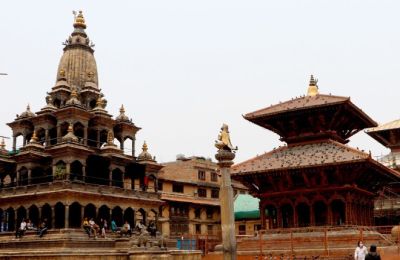
Kathmandu Valley Sightseeing Tour - 6 days
Kathmandu Valley Sightseeing tour is an in-depth overland tour inside the Kathmandu valley suited for all kinds of tourists, whether individuals, groups, or families.
Inquire Now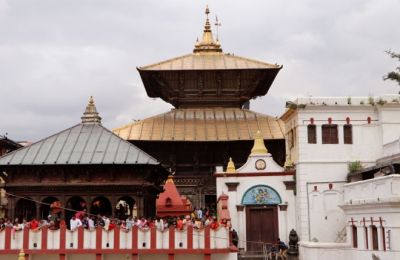
Nepal Hindu Pilgrimage Tour - 8 days
The Nepal Hindu Pilgrimage Sightseeing Tour offers the most spiritual experiences in a short period. The eight-day tour is an in-depth exploration and insight into the Nepalese culture and traditions.
Inquire NowWhere to travel next?
Get help from our travel specialists for holiday ideas that matches your interests.
6. Janakpur - The Birthplace of Sita
Janakpur is renowned as the birthplace of Sita and the setting for the union of Lord Ram (an incarnation of Lord Vishnu) and Sita. This divine place in Nepal's southeastern plains is also narrated in the Hindu epic Ramayana.
The Janakpurdham has acquired its significance also from the majestic structure of the JanakiMandir, constructed in 1910 by the Queen of India. The temple showcases amazing Rajput and Mughal architecture and is dedicated to Goddess Sita. The museum artistically shows how Goddess Sita was born to King Janak and how the legendary love story of Lord Ram and Sitabegan. There are also ornate carvings and vibrant paintings on the walls with captivating artistry and spirituality.
Surrounding the location are the Maithili ethnic groups who visit the temple frequently, along with the internal tourists and visitors from neighboring India. This is a cultural gem of the Hindu mythology and a spiritual place.
7. Manakamana Temple
The name of Manakamana Temple, dedicated to the Hindu goddess Bhagwati, an incarnation of Parvati, is translated to "the wish-fulfilling goddess." It is believed that offering prayers to the temple will grant them their deepest desires, which is why the temple has gained great significance. Moreover, the location of the temple perched atop a ridge in the Gorkha district of Nepal, which can be reached only through cable cars, is another reason for its popularity.
Hindus primarily follow the temple, but other ethnic groups and tourists also visit the place due to its lush green surroundings and spirituality. The origin of the temple dates back to the 17th century when the King discovered a miraculous stone representing the goddess Bhawani. The architecture is distinctively pagoda style and is adorned with intricate wood carvings.
The unique setting and spiritual aura of the goddess's divine presence offer cultural relevance to those seeking blessings.
8. Tengboche Monastery
One of the most uniquely located sacred sites on the list is certainly Tengboche Monastery. Nestled in the Everest region of Nepal, the Buddhist site makes up for a wonderful destination. The monastery was constructed in 1916 and has seen reconstructions after major earthquakes in Nepal. It is one of the most revered sacred sites for Tibetan Buddhists. Legends suggest that one of the Lama, Sangwa Dorge, saw visions of this place and hence chose it as a sacred site.
Tengoche boasts traditional Tibetan architecture with colorful frescoes, intricate wood carvings, and a massive prayer wheel. The monastery sees huge folks of pilgrims during the annual festivities. The temple's surrounding area offers panoramic views of the mountains in the region, including the highest mountain in the world, Mt. Everest.
Inside the monastery, you'll observe monks and Sherpas engaging in the daily routine of prayers and religious ceremonies, as this is a major religious hub for the ethnic indigenous group in the Everest region. You will witness trekkers, hikers, and mountain climbers taking blessings as they visit the monastery on their journey to Everest. It offers a breathtaking view of the confluence of culture and nature during the Everest trekking experience.
9. Gosaikunda Lake
A unique one on the list is Gosaikunda, as it is a sacred lake. It is a pristine alpine lake nestled in the Langtang National Park of Nepal and is believed to be the residing place of Lord Shiva. Folklore suggests that Lord Shiva drank from the water of the lake to cool his throat after consuming poison during the churning of the cosmic ocean; hence, it holds sacred significance for both Hindus and Buddhists.
Perched at an altitude of about 4,380 meters, Gosaikunda is a glacial lake where pilgrims are believed to rid themselves of any wrongdoings by dipping themselves in the ice-cold water of the lake and doing prayers.
While there are different beliefs surrounding the lake, it is not only a spiritual pilgrimage but an amazing spiritual place with Himalayan views. Snowcapped mountains, along with a series of lakes and ponds, can be spotted nearby.
Pilgrims flock to the site annually during a festival, while tourists visit the place often during their trek in the Langtang Valley. The serenity of the bluewater and the prayer flags fluttering in the wind offer a tranquil setting.
10. Budanilkantha Temple
Budanilkantha temple has a legend of its own on how the statue of Lord Vishnu emerged back during the Lichchhavi dynasty era. The amazing aspect of the statue is that it is perfectly stone carved and 5 meters in length with Lord Vishnu in a cosmic sleep on the coiled body of a serpent named Shesha. The temple was then formed around the location where the statue was spotted in the 5th century, adding to the allure of the sacred site. Now, the temple has the majestic statue of Vishnu sleeping in a bed of water.
The remarkable temple on the Kathmandu Valley's northern edge sees devotees from various ethnic backgrounds, including Newars and Brahmins, to offer prayers and seek blessings from Lord Vishnu. The site's tranquil ambiance and the presence of sleeping Vishnu make the place worth visiting.
Other religious sites worth visiting
Apart from the above top 10, the following are some additional sacred sites you can visit during your stay in Nepal:
Durbar Squares
The Durbar Squares of Bhaktapur, Kathmandu, and Patan in the Kathmandu valley are home to some of the revered temples, old palaces, and monasteries. These are also all UNESCO World Heritage sites with a rich history of civilization in Nepal.
Changu Narayan Temple
Perched atop a hill near Bhaktapur, this is one of the oldest temples in Kathmandu. It is dedicated to Lord Vishnu and known for its intricate stone carvings.
Namo Buddha
Located in the Kavrepalanchok District, is believed to be where Buddha, in a previous life, selflessly offered his body to a starving tigress and her cubs. Hence, it is a sacred site for Buddhists.
Barahi Temple
The two-story pagoda-style Hindu temple is located on an island in Phewa Lake, Pokhara. It is famous for its unique setting and is dedicated to the goddess Barahi.
Dakshinkali Temple
The Hindu temple on Kathmandu's southern outskirts is dedicated to goddess Kali. The pagoda-style temple is known to host annual animal sacrifices dedicated to the fierce goddess.
Pathivara Temple
The elevated temple in the hills of Taplejung, Nepal, at 3,794 meters, is dedicated to Goddess Pathivara. It is revered for its stunning location and traditional architecture.
Conclusion
Nepal's beautiful sacred sites showcase ancient times' architectural and religious significance. Take this unique opportunity to connect with the spiritual essence of this Himalayan country. If you like what you've read and would want to hop on the next flight to Nepal, reach out to our travel agents, who'll help you organize the tour of a lifetime.
Where to travel next?
Get help from our travel specialists for holiday ideas that matches your interests.
- Written by: Naba Raj Amgai
Updated: Jan, 31, 2024

